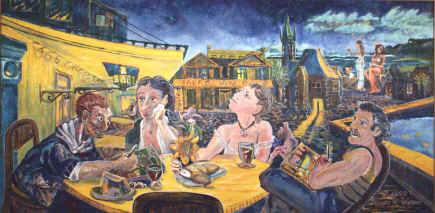| By John T. Spike Once upon a time, everybody learned to read from the Bible, The Iliad and The Odyssey, and artists could sculpt David and paint Vulcan's Forge with the confidence that their viewers were on the same page. Though our love for Rembrandt is undiminished, we have forgotten why he shows Aristotle contemplating a bust of Homer. It's enough that it was important to Rembrandt. And therein lies a rule for artists: Choose subjects that touch you personally. Unless you care, we won't either. But what's an artist to do? Our museums are filled with masterpieces that require explanation. We revere the Old Masters as inspirations, but every generation needs its own artists to reveal it. Putting symbols in a model's hand and calling him Mercury is not the answer in 2005. Maybe it helps to recall that Rembrandt's Night Watch and Velazquez's Las Meninas were presented as eyewitness glimpses of real events. (Of course, they contain so much more, but that's the part that makes them great.) When America was flexing her young muscles, Charles Demuth painted a Pensnsylvania grain elevator and called it My Egypt. We still love that picture for its optimism,. Contemporary artists are champing at the bit to tell tender, astounding, romantic, mysterious stories --- whatever --- but whose mythology has replaced the Greeks? |
 Portrait Battle by Donald R Ricker is an unpretentious yet thoroughly enjoyable history painting for our time. Even if the title makes no allusion, is there anyone who doesn't recognize the earnest young man as Vincent van Gogh? And the yellow canopy behind him as a café in one of his paintings? We take it in at a glance: this has to be van Gogh and Paul Gauguin together in Arles, France, ensconced, as every night at a café with a pair of girls. Next we look to see if his ear's intact . It is. That tells us where we are in a story everyone knows, even if they've never read Lust for Life by Irving Stone or seen the movie starring Kirk Douglas. That's what popular mythology means. It also has to seem relevent. Van Gogh goes deep for us . He has become the patron saint of artist-martyrs. "This world was never made for one as beautiful as you," goes the pop song by Don McLean. Ricker catches him leaning forward eagerly making a point. " I have been blessed with the urge to create, to evoke thought and to share knowledge. It's a human thing. 'To live was more than just to survive ...'" The words sound like Vincent's , but they're pure Ricker, a towering Alaskan with a giant jaw like Gary Cooper. No wonder he chose van Gogh for a portrait intended to compete with an admired artist (hence, Portrait Battle). Visiting this painting is like dropping in on two old friends who will never change. That's what comes with mythic status. As Vincent pushes forward, eager to make some comradely observation, cool, aloof Gauguin leans away, his gaze distracted. Behind him are glimpses of two places he'd rather be Pont-Aven and the Tahitian shores. Both meaning well, they're locked in the futility of reconciling van Gogh's dream of a brotherhood of painters with Gauguin's inability to form attachments. The story is familiar enough to be told tongue-in-cheek and still be poignant. Some realists will object to Ricker's impromptu style, but van Gogh wouldn't mind. Funny, but looking into the facts as Portrait Battle makes you want to do, you discover that Ricker hasn't tried to copy the faces and details exactly. The house with the Tabac sign is as it is known from a 1936 photograph, not as van Gogh painted it when he had his famous room there. The nights were too cold and rainy that miserable November and December of 1888 to sit outside. So Ricker's telling of this myth is all wrong --- which doesn't mean that it isn't true. Art & Antiques Florence, Italy correspondent John T Spike is the director of the Florence International Biennale of Contemporary Art. |